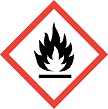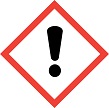GHS Classification Result
PHYSICAL HAZARDS
HEALTH HAZARDS
ENVIRONMENTAL HAZARDS
NOTE:
Reference:
Chemical Name:2-Methylbutanol
CAS:137-32-6
Result:
| ID: | 22A4114 |
| Classifier: | Ministry of Health, Labour and Welfare (MHLW), Ministry of the Environment (MOE) |
| Year Classified: | FY2010 |
| Reference Manual: | GHS Classification Guidance by the Japanese Government (July, 2010) |
PHYSICAL HAZARDS
| Hazard class | Classification | Symbol | Signal word | Hazard statement | Precautionary statement | Rationale for the classification | |
|---|---|---|---|---|---|---|---|
| 1 | Explosives | Not applicable | - | - | - | - | There are no chemical groups associated with explosive properties present in the molecule. |
| 2 | Flammable gases (including chemically unstable gases) | Not applicable | - | - | - | - | Liquid (GHS definition) |
| 3 | Aerosols | Not applicable | - | - | - | - | Not aerosol products. |
| 4 | Oxidizing gases | Not applicable | - | - | - | - | Liquid (GHS definition) |
| 5 | Gases under pressure | Not applicable | - | - | - | - | Liquid (GHS definition) |
| 6 | Flammable liquids | Category 3 |

|
Warning | H226: Flammable liquid and vapour |
P303+P361+P353: IF ON SKIN (or hair): Remove/Take off immediately all contaminated clothing. Rinse skin with water/shower. P370+P378: In case of fire: Use ... for extinction. P403+P235: Store in a well-ventilated place. Keep cool. P210: Keep away from heat/sparks/open flames/hot surfaces. - No smoking. P233: Keep container tightly closed. P240: Ground/bond container and receiving equipment. P241: Use explosion-proof electrical/ventilating/lighting/.../equipment. P242: Use only non-sparking tools. P243: Take precautionary measures against static discharge. P280: Wear protective gloves/protective clothing/eye protection/face protection. P501: Dispose of contents/container to ... |
Since its flash point reported 43 degC (closed-cup) (Solvent Pocketbook (1994)) is >= 23 degC and <= 60 degC, the substance is classified into Category 3. |
| 7 | Flammable solids | Not applicable | - | - | - | - | Liquid (GHS definition) |
| 8 | Self-reactive substances and mixtures | Not applicable | - | - | - | - | There are no chemical groups present in the molecule associated with explosive or self-reactive properties. |
| 9 | Pyrophoric liquids | Not classified | - | - | - | - | Since its autoignition temperature is 400 degC (Ullmanns (E) (6th, 2003)), it is considered that the substance does not ignite at room temperature. |
| 10 | Pyrophoric solids | Not applicable | - | - | - | - | Liquid (GHS definition) |
| 11 | Self-heating substances and mixtures | Classification not possible | - | - | - | - | Test methods applicable to liquid substances are not available. |
| 12 | Substances and mixtures which, in contact with water, emit flammable gases | Not applicable | - | - | - | - | The chemical structure of the substance does not contain metals or metalloids (B, Si, P, Ge, As, Se, Sn, Sb, Te, Bi, Po, At). |
| 13 | Oxidizing liquids | Not applicable | - | - | - | - | The substance is an organic compound containing oxygen (but not fluorine or chlorine) which is chemically bonded only to carbon or hydrogen. |
| 14 | Oxidizing solids | Not applicable | - | - | - | - | Liquid (GHS definition) |
| 15 | Organic peroxides | Not applicable | - | - | - | - | Organic compounds containing no bivalent -O-O- structure. |
| 16 | Corrosive to metals | Classification not possible | - | - | - | - | No data available. |
| Hazard class | Classification | Symbol | Signal word | Hazard statement | Precautionary statement | Rationale for the classification | |
|---|---|---|---|---|---|---|---|
| 1 | Acute toxicity (Oral) | Not classified | - | - | - | - | Based on the rat LD50 value of 4010 mg/kg (JECFA (2004)), the substance was classified as "Not classified" in the JIS classification (corresponding to Category 5 in the UN-GHS classification). |
| 1 | Acute toxicity (Dermal) | Not classified | - | - | - | - | Based on the rabbit LD50 value of 2.89 g/kg (PATTY, 5th (2001)), the substance was classified as "Not classified" in the JIS classification (corresponding to Category 5 in the UN-GHS classification). |
| 1 | Acute toxicity (Inhalation: Gases) | Not applicable | - | - | - | - | Liquid (GHS definition) |
| 1 | Acute toxicity (Inhalation: Vapours) | Classification not possible | - | - | - | - | No data available. |
| 1 | Acute toxicity (Inhalation: Dusts and mists) | Classification not possible | - | - | - | - | No data available. |
| 2 | Skin corrosion/irritation | Not classified | - | - | - | - | Minimal irritation to skin was reported (HSDB (2002)). And in the rabbit test, slightly irritation was noted (PATTY, 5th (2001)). Based on these documents, the substance was classified as "Not classified" in the JIS classification (corresponding to Category 3 in the UN-GHS classification). |
| 3 | Serious eye damage/eye irritation | Category 2 |

|
Warning | H319: Causes serious eye irritation |
P305+P351+P338: IF IN EYES: Rinse cautiously with water for several minutes. Remove contact lenses, if present and easy to do. Continue rinsing. P337+P313: If eye irritation persists: Get medical advice/attention. P264: Wash ... thoroughly after handling. P280: Wear protective gloves/protective clothing/eye protection/face protection. |
In the rabbit test, severe irritating was reported (PATTY, 5th (2001)). And in another rabbit test, skin irritation score after the 24-hour application was 8 by grading according to 10 ranks (maximum score in severe injury was 10) (HSDB (2002)). Based on these documents, the substance was classified as Category 2. |
| 4 | Respiratory sensitization | Classification not possible | - | - | - | - | No data available. |
| 4 | Skin sensitization | Classification not possible | - | - | - | - | No data available. |
| 5 | Germ cell mutagenicity | Not classified | - | - | - | - | The classification was concluded as "Not classified" based on the negative results in the micronucleus test by oral administration to mice (in vivo mutagenicity test) (Evaluation of effect for the food safety (Food Safety Commission) (2006)). As relevant information, as for in vitro studies, negative results in the Ames test, chromosome aberration test using CHL/IU cells, micronucleus test using Chinese hamster V79 cells and HPRT gene mutation test using Chinese hamster V79 cells (Evaluation of effect for the food safety (Food Safety Commission) (2006)) were reported. |
| 6 | Carcinogenicity | Classification not possible | - | - | - | - | No data available. |
| 7 | Reproductive toxicity | Classification not possible | - | - | - | - | No data available. |
| 8 | Specific target organ toxicity - Single exposure | Classification not possible | - | - | - | - | No data available. |
| 9 | Specific target organ toxicity - Repeated exposure | Classification not possible | - | - | - | - | In the 90-day repeated oral dose (gavage) study in rats (dose levels: 0, 30, 100, 300 and 1000 mg/kg/day), AST activity was elevated in females of the treatment groups at 300 mg/kg/day or higher without any histopathological changes. While in the same treatment groups at 300 mg/kg/day or higher, an enhancement of light reflex in ocular fundus was observed in the ophthalmological examination. The finding was evaluated as a toxic effect, and NOAEL in this study was judged as 100 mg/kg/day (Evaluation of effect for the food safety (Food Safety Commission) (2006)). Thus, the classification was equivalent to "Not classified" category for oral route. However, the classification for specific target organ toxicity (repeated exposure) was concluded as "Classification not possible" due to unspecified effects in the other routes. |
| 10 | Aspiration hazard | Classification not possible | - | - | - | - | No data available. |
| Hazard class | Classification | Symbol | Signal word | Hazard statement | Precautionary statement | Rationale for the classification | |
|---|---|---|---|---|---|---|---|
| 11 | Hazardous to the aquatic environment (Acute) | Classification not possible | - | - | - | - | No data available. |
| 11 | Hazardous to the aquatic environment (Long-term) | Classification not possible | - | - | - | - | No data available. |
| 12 | Hazardous to the ozone layer | Classification not possible | - | - | - | - | This substance is not listed in Annexes to the Montreal Protocol. |
NOTE:
|
* Classification was conducted by relevant Japanese Ministries in accordance with GHS Classification Guidance for the Japanese Government, and is intended to provide a reference for preparing GHS labelling and SDS for users. * This is a provisional English translation of classification results and is subject to revision without notice. * The responsibility for any resulting GHS labelling and SDS referenced from this site is with users. |
Reference:
|
Reference Manual |
|
|
Definitions / Abbreviations |
|
|
Model Label by MHLW |
MHLW Website (in Japanese Only) |
|
Model SDS by MHLW |
MHLW Website (in Japanese Only) |